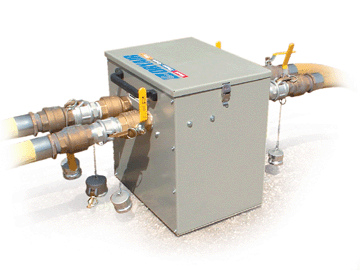
– Patent Pending –
- Electrical requirements – 115V, single phase, 15A.
- Controls – electro-mechanical timer controls the switching of motorized valves.
- Fluid Circulation – can be incoporated to all DryAir systems
- 2″, 50mm Kamlock quick coupler fluid line connections
- 1″, 25mm Quick coupler adapters available
SmartThaw System – STS 100
- Shave days off your thawing time
- Provides “even” line heat exchanger heat distribution
- Enhances ground thaw and concrete cure applications
The Problem
With conventional lineal tube heat exchangers (thaw/cure hose), there are inherent drawbacks; As fluid travels along a thaw/cure hose, the temperature difference continues to increase until some portion of the length may not achieve adequate heat transfer. In certain applications the results may be unsatisfactory.
The Solution
- The SmartThaw System reverses the direction of flow through the thaw/cure hose, at predetermined, equal time intervals.
- The SmartThaw System process creates equal transfer of heat throughout… very desirable in ground thaw and concrete cure applications.
- Utilizing a Smartthaw System, “even” heat distribution will be maintained throughout the length of the “thaw/cure hose”
Ground thaw application
In most ground thaw situations, the thawing profile will be uneven due to uneven heat distribution. Most contractors will continue thawing until all areas thaw down to the frost line. The area under the cooler part of the “thaw/cure hose” will naturally take much longer. Utilizing a SmartThaw System, the ground thaw will progress, maintaining an “even thawing profile”. This can shave days off your thawing time and, in turn, significantly reduce fuel costs.
Concrete cure application
Concrete curing is a far more critical application as far as the proper distribution of heat is concerned. With conventional thaw/cure hose, high temperature differential can cause two serious problems. The rate of curing is often very different from one side of the loop to the other. In certain situations, the different rate of curing can cause stress points and cracking thus reducing the overall quality of the concrete. When ambient temperatures drop well below freezing, The heat transfer from the cooler part of the “thaw/cure hose” may not be adequate to maintain proper curing temperatures. In fact, the concrete surface temperatures, in these cases, could be as low as 40°F. The concrete between the “thaw/cure hose” loops may be at risk of freezing and could lead to catastrophic failure of the concrete. Utilizing a SmartThaw System, “even” heat distribution will be maintained throughout the length of the “thaw/cure hose” and the curing problems, as outlined above, can be avoided.

